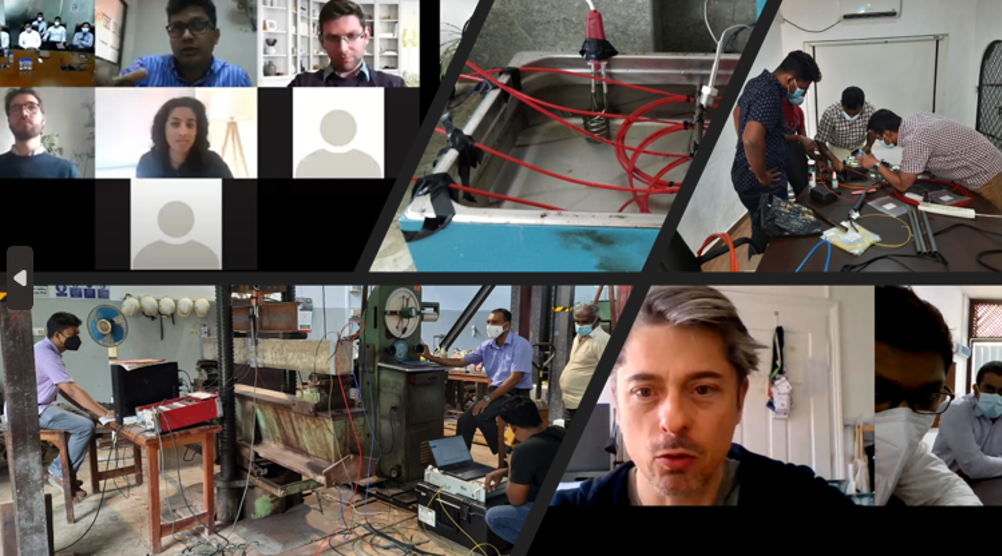Category: Information, data and connectivity
Headline Sponsor: Babcock International Group
Project: Innovative Pre-Straining Tools and BOFDA Technology assessment: A Transnational Leap in Infrastructure Monitoring
Partners: Cambridge Centre for Smart Infrastructure and Construction (CSIC), University of Moratuwa, Sri Lanka; University of Oxford; Access Engineering PLC, Sri Lanka; Laing O’Rourke Centre, University of Cambridge; fibrisTerre Systems GmbH, Germany; University of Qatar; WSP UK Limited
From the impacts of climate change to the pressures caused by accelerating urbanisation, the race is on to ensure that our built environment and infrastructure is as resilient as it can possibly be. And one of the keys to addressing this constantly evolving landscape is the development of structural health monitoring techniques that deliver real-time data on the health of infrastructure, enabling operators to spot and address potential issues before they become a problem.
The winner of the 2023 C2I Awards Information, Data & Connectivity category is at the forefront of this push and has driven a number of key advances in the deployment and understanding of highly accurate fibre optic structural health monitoring technologies.
Led by the Cambridge Centre for Smart Infrastructure (CSIC) at the University of Cambridge but involving a range of collaborative partners, this cross-border, cross-disciplinary project was initiated to explore a specific, relatively new Fibre Optic Monitoring technology known as Brillouin Optical Frequency Domain Analysis (BOFDA).
By carrying out a rigorous and critical assessment of this technology and comparing its effectiveness to strain gauge measurements and analytical predictions, the team was able to provide a robust validation of the technology’s capabilities and lay much of the groundwork for its worldwide application.
However, alongside its work on BOFDA the team made a number of further breakthroughs in the field of fibre optic monitoring.
One of the key additional innovations was the development of a new tool that could vastly improve the accuracy of the optical fibres used in structural monitoring applications.
This work was related to the question of whether there is a need for pre-straining fibres embedded in the compression zones of concrete. The prevailing assumption has been that the surrounding concrete provides sufficient confinement, thus eliminating the need for pre-tensioning. However, the project’s findings - which emerged from rigorous laboratory tests - indicate that this is not in fact the case and that pre-straining can significantly improve the accuracy of fibre optic monitoring systems.
This led to the development of a pre-straining tool that can be affixed to reinforcement bars to provide the requisite pre-strain to the fibres, for which the team now aims to submit a patent application. The partners believe that this innovation has the potential to revolutionise the way fibre optic monitoring is implemented, particularly in settings where the structural elements are subjected to compressive forces.
Other key achievements throughout the project included the introduction of fibre optic monitoring technology to Sri Lanka (a country with a heavy investment in infrastructure but limited access to advanced SHM systems); and a thorough examination of attachment mechanisms for embedding the fibre optic cables. This is a critical aspect as the provided pre-strain can only be retained if there is a reliable attachment. Various attachment mechanisms were evaluated for their efficacy in maintaining the integrity of the Fibre Optic cables, especially under challenging environmental conditions.

Collaboration was at the heart of the project from its inception. The project was initially kickstarted with a workshop involving Oxford, Cambridge, Moratuwa universities and Access Engineering. After this, research students were recruited, and a structured research program was rolled out.
Specialised training for fibre optic monitoring equipment was provided by fibre optic specialist Fibristerre, while experts from WSP and Qatar University joined later stages to lend their expertise on pre-straining.
The Cambridge Centre for Smart Infrastructure (CSIC) led the way with its extensive experience in fibre optic monitoring. It also shaped the research agenda and provided guidance on the development of the experimental programme. The expertise from the University of Oxford was offered to develop the research project and interpret the outcomes of the experimental programme. Meanwhile, industrial partner Access Engineering PLC provided the financial backbone and also contributed specialised tools, such as splicing, a critical component for the implementation of the Fibre Optic Monitoring system.
Enabling effective collaboration across such a geographically dispersed team was a key challenge. To address this small, specialised teams were formed based on the expertise required at different phases of the project. This allowed for focused, efficient work without waiting for the entire collaborative team to be available.
Another hurdle, given the wide range of expertise involved, was reconciling diverse expert opinions. Again, this was managed by prioritising feedback based on the project phase and the specific expertise needed at that moment, ensuring that the most relevant and impactful insights were incorporated into the project’s development.
Hailed by its team as a “significant milestone in the field of civil engineering and infrastructure management” the project has led to significant advances in the field of structural health monitoring with global ramifications. What’s more, in addition to its technological advancements, it has been instrumental in training students and industry professionals, thus ensuring the effective implementation and sustainability of these new technologies. This focus on capacity-building creates a skilled workforce that can apply this advanced technology across a range of infrastructure projects, amplifying the project’s long-term impact.











Emergency law passed to protect UK steelmaking
<b>(:-))</b> Gareth Stace as director general of trade body UK Steel, is obviously an expert on blast furnace technology & operation. Gareth...